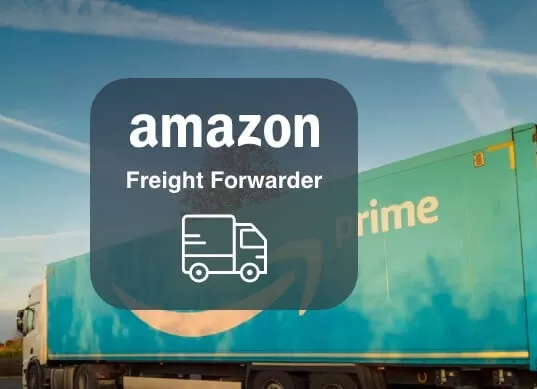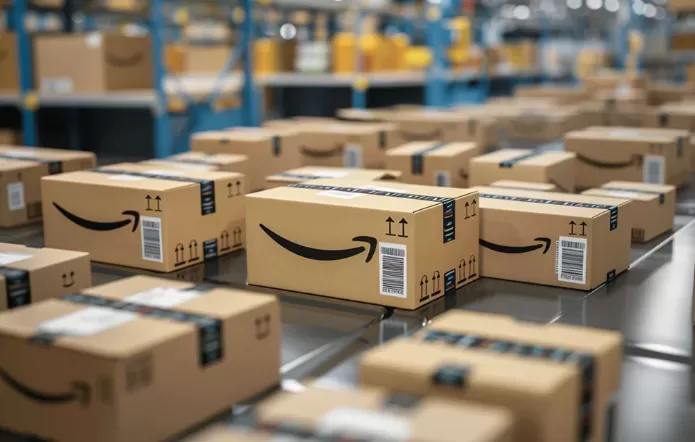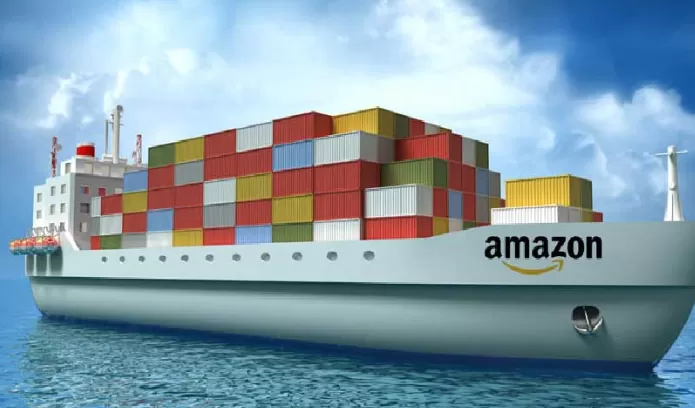If you're asking this question, you've already hit the first major wall in scaling your Amazon FBA business. The dream is simple: your products are made, they fly off Amazon's shelves, and the money rolls in. But the reality of getting those products from a factory overseas to an Amazon FBA warehouse is where the dream meets a tangled web of logistics, customs, and compliance headaches.
So, let's cut to the chase: You need a freight forwarder for Amazon FBA not because it's an added service, but because it's a non-negotiable component of a professional, scalable, and profitable supply chain.
Think of it this way: you wouldn't represent yourself in a complex court case. You'd hire a lawyer. A freight forwarder is your legal and logistical counsel for international trade. They navigate the complexities so you can focus on what you do best: growing your business.
Here’s a breakdown of what we’ll cover:
The 5 Unavoidable Reasons You Can’t Go It Alone
The Real Cost & Timeline Breakdown Others Won’t Show You
A Step-by-Step Action Plan to Get It Right
The 5 Unavoidable Reasons You Can’t Go It Alone
Here’s the thing: customs authorities don't care about your Amazon seller rankings. They care about compliance. A single mistake in your documentation—like an incorrect HS code (the international standard for classifying products)—can lead to your entire shipment being held, inspected, or even destroyed.
The Real Risk: We've seen sellers face $10,000+ in unexpected demurrage (port storage fees), fines, and lost sales because they tried to handle customs clearance themselves. One client nearly had their plastic kitchenware seized because it was misclassified as a "toys and games" item, triggering different safety regulations.
How a Forwarder Solves This: They have licensed customs brokers on their team. They ensure your HS codes, commercial invoices, and certificates of origin are 100% accurate from the start. They handle the direct communication with customs, solving problems before they ever reach you.
2. Amazon’s FBA Compliance Rules Are a Moving Target
Amazon doesn't just receive boxes. They have a strict, ever-changing list of requirements for palletization, labeling, and shipment creation. Get this wrong, and Amazon will simply refuse your inventory at the receiving center. This isn't a hypothetical; it's a daily occurrence.
The Specifics That Trip Sellers Up:
Pallet Requirements: Height and weight restrictions, specific pallet types (e.g., no wood from certain countries without heat treatment), and stretch-wrapping standards.
Labeling: Every single box needs the correct FBA shipment ID label in the exact right size and placement. Smudged or misaligned labels cause massive delays.
Appointment Scheduling: Amazon requires precise delivery appointments. Missing one can mean truckers waiting for hours, incurring detention fees that come out of your pocket.
How a Forwarder Solves This: An FBA-experienced forwarder doesn't just ship your cargo. They manage the "final mile" logistics. They ensure your cartons are palletized to Amazon's specs, labels are applied correctly, and appointments are booked and adhered to, seamlessly bridging the gap between the port and the fulfillment center.
You might think going directly to a shipping line is cheaper. It’s not. The headline ocean freight rate is just the tip of the iceberg. The real costs are hidden in a dozen ancillary fees.
Let's break down the real cost of a sample LCL (Less than Container Load) shipment from China to the USA:
| Cost Component |
Estimated Fee |
Often Overlooked? |
| Ocean Freight (LCL) |
$120 - $180 per CBM |
No |
| Origin Charges (Handling, Docs) |
$50 - $100 |
Yes |
| Export Customs Declaration |
$30 - $60 |
Yes |
| Insurance (0.3% of cargo value) |
Variable |
Often Skipped, Big Risk |
| Destination Port Fees |
$200 - $400 |
Yes |
| Customs Clearance |
$150 - $300 |
Yes |
| Duty & Taxes |
Varies by product |
Yes |
| Trucking to Amazon (FTW1) |
$500 - $900 |
Yes |
| Amazon Inbound Placement Fee |
Varies |
Yes |
| Potential: Demurrage/Detention |
$100+/day |
Yes - A Hidden Killer |
A freight forwarder consolidates all this into a clear, all-in quote. More importantly, they use their volume to negotiate better rates with carriers and have the expertise to avoid those catastrophic hidden fees.
4. Making the Right Transport Decision: Sea vs. Air vs. Rail
This isn't just about speed versus cost. It's about cash flow, seasonality, and product lifecycle.
Sea Freight: Your default for cost-effectiveness.
Best for: High-volume, low-cost, non-seasonal goods.
The Catch: You need to forecast demand 60-90 days in advance.
Air Freight: Your strategic tool for agility.
Best for: Launching new products, emergency restocks, high-value/low-volume items.
The Catch: Cost is 4-6x more than sea freight. It's not for your core inventory.
Rail Freight (China-Europe): The middle ground.
Best for: Balancing cost and time for Central European markets.
The Catch: Slightly less predictable than sea, and geopolitical factors can influence reliability.
A good forwarder won't just quote you prices; they'll act as a consultant, helping you choose the right mode—or a blend of modes—based on your business goals.
5. Risk Management and End-to-End Visibility
When you hand your cargo to a random carrier, it often enters a black box. You have no idea where it is until it (hopefully) arrives. This is no way to run a business.
Cargo Insurance: Any forwarder worth their salt will insist you insure your shipment. For a small percentage of the cargo value, you protect yourself against loss, damage, or theft. It's not an expense; it's a necessity.
Real-Time Tracking: Professional forwarders provide a single platform where you can see your shipment's status—from factory pickup to port arrival, to vessel location, to final delivery at Amazon. This visibility allows you to manage your cash flow and marketing campaigns with confidence.
The Complete Timeline & Process: No More Guesswork
One of the biggest frustrations is not knowing where your goods are. Here’s a realistic timeline for a sea freight shipment from China to an Amazon FBA warehouse in the US.
The Typical 35-45 Day Journey:
Days 1-3: Factory Pickup & Export Customs. Your forwarder collects the goods and handles all export formalities in China.
Days 4-7: Origin Warehouse. Goods are consolidated with other shipments, palletized, and labeled for FBA.
Day 8: Port Arrival & Loading. Your container is loaded onto the vessel.
Days 9-30: Ocean Transit. The vessel sails across the Pacific. This is where good tracking gives you peace of mind.
Day 31: Port Arrival (e.g., LA/Long Beach). The ship arrives, and the container is unloaded.
Days 32-33: Customs Clearance. Your forwarder's brokerage team submits paperwork to US Customs. This is the most critical stage where amateurs fail.
Day 34: Container Unloaded & Palletized. The container is moved to a warehouse, de-stuffed, and the pallets are prepared for the final truck journey.
Day 35: Truck Dispatch to Amazon. A dedicated truck is sent to the designated FBA warehouse (e.g., FTW1, ONT8).
Days 36-38: Amazon Receiving. Amazon unloads the truck and begins scanning your units into their inventory. Note: Delays here are common during peak seasons like Q4.
Don't just pick the cheapest quote. You're choosing a logistics partner.
Ask These 10 Critical Questions:
"Can you provide 2-3 references from current Amazon FBA clients?"
"Who on your team is the licensed customs broker, and what is their experience with my product category?"
"What is your specific process for ensuring FBA compliance (labeling, pallets, appointments)?"
"Walk me through your cargo tracking platform. Is it real-time?"
"How do you handle claims if my goods are damaged or lost?"
"What are ALL the potential hidden fees I should be aware of?"
"What is your communication plan? Who is my single point of contact?"
"Do you offer cargo insurance, and what does it cover?"
"What happens if my shipment is delayed at customs?"
"Can you help me determine the best Incoterms (e.g., FOB vs. EXW) for my situation?"
The Bottom Line
Trying to handle international freight for Amazon FBA yourself is a high-risk, low-reward strategy. The potential savings are illusory, while the risks of delays, fines, and compliance failures are very real.
A professional freight forwarder isn't a cost; it's an investment in your supply chain's reliability, scalability, and ultimately, your profitability. They provide the expertise, infrastructure, and negotiating power that you, as an individual seller, simply cannot replicate.
Ready to Stop Guessing and Start Scaling?
Get a free, no-obligation consultation and a transparent quote tailored to your specific Amazon FBA needs. We'll audit your current process and show you exactly how to optimize your supply chain for cost and reliability. [Contact Our FBA Logistics Experts Today.]
FAQs
1. Q: My supplier offered to handle shipping for me. Why shouldn't I just let them do it?
A: While convenient, this often means less control and transparency for you. Your supplier's primary goal is to get the goods out of their factory. They may not be optimizing for the lowest cost or best route for the final leg to Amazon, and they almost never specialize in FBA's strict compliance rules. Using your own forwarder creates a checks-and-balances system and ensures your interests are prioritized from origin to destination.
2. Q: What happens if my goods arrive at the Amazon warehouse but are damaged?
A: This is a three-step process. First, you file a problem with Amazon Seller Central to determine if the damage occurred after they received it. If Amazon confirms they received it damaged, you then file a claim with the freight forwarder's cargo insurance. We'll guide you through the evidence needed (photos, Amazon's report) to get you compensated. The key is having that insurance in place from the start.
3. Q: I sell in both the US and EU. Can one freight forwarder handle my shipments to both marketplaces?
A: Absolutely. A robust forwarder will have established partners and expertise in all your key markets. In fact, using a single partner for multiple regions simplifies your life immensely. You'll have one point of contact, one tracking platform, and consolidated invoicing, making it much easier to manage your global logistics strategy.
4. Q: How do you handle "split shipments" when I'm sending one production run to multiple Amazon warehouses?
A: This is a core part of FBA logistics. We handle this seamlessly. We'll collect your full shipment at origin, then use our distribution network to split and palletize the goods according to Amazon's required distribution plan. We then coordinate separate trucks for each FBA location, all under a single master shipment that you can track.
5. Q: My products are not palletized. How do you get loose cartons accepted by Amazon?
A: We can handle both options. For loose cartons (which Amazon calls "small parcel deliveries"), we partner with carriers like UPS or FedEx for the final leg. The process is the same: we receive your loose cartons, ensure every one has the correct FBA label, and then tender them to the small parcel carrier for delivery. The key is ensuring 100% label accuracy to avoid rejections.
6. Q: What's the lead time I should give you between ordering from my supplier and having the goods ready to ship?
A: A good rule of thumb is to contact us as soon as you place your factory order. This gives us 1-2 weeks to arrange everything before the goods are ready for pickup. Rushing this process leads to mistakes and higher costs. The golden rule is: the more lead time you can give us, the more options and better rates we can secure for you.
7. Q: I only have a few cartons to send; is a freight forwarder still a good fit for me?
A: For very small shipments (e.g., under 100 kg), a courier service like DHL or FedEx might be more straightforward. However, as soon as your volume grows to even a few cubic meters (CBM), our LCL (Less than Container Load) service becomes highly cost-effective. We can consolidate your small shipment with others, giving you access to freight rates and handling the complex customs work that couriers often leave to you.
8. Q: What information do you need from me to provide an accurate shipping quote?
A: To get you a firm, all-in quote, we need just a few key details:
Product description and HS code (if you know it).
Total cargo dimensions and weight (CBM and kg).
Pickup address (factory) and destination Amazon FBC.
Your Incoterm (e.g., FOB Shanghai or EXW Shenzhen).
With this, we can provide a transparent breakdown of all costs, so there are no surprises.
9. Q: Can you help me if I need to remove inventory from Amazon and send it to a different location?
A: Yes, this is a service called "FBA Removal Order Handling." We can coordinate with Amazon to have your inventory pulled from the fulfillment center, shipped to our nearby warehouse, and then we can dispose of it, relabel it, or even ship it to a different marketplace for you. It’s a lifesaver for dealing with returns or stranded inventory.

 EN
EN
 FR
FR
 ES
ES
 JA
JA
 PT
PT
 RU
RU
 AR
AR







